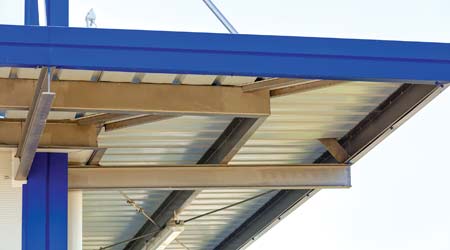Commissioning Goals: Reduce Air Leakage, Eliminate Thermal Bridges, Control Water Intrusion
Part 2 of a three-part Green Building Report.
In many cases, facility managers will hire a BECxA (building enclosure commissioning agent) to manage the commissioning process. A BECxA, as the term implies, is entirely focused on the exterior shell of the building. This person has a triple mandate of reducing air leakage, eliminating thermal bridges, and controlling water intrusion in the building. To achieve these goals, the BECxA works with the design team and facility manager to determine the components of the wall and roof that will work best to control air leakage, heat transmission, and moisture. These “control layers” can be obtained by a single material such as taped exterior rigid sheathing, or multiple materials, depending on various factors. Ensuring the continuity of these “control layers” at changes in building cladding, intersection of the wall and roof planes, pipe/utility penetrations, fenestrations, etc., is the single most important task in building enclosure commissioning and is responsible for achieving the three objectives outlined above. This approach looks at the building skin as a complete and inter-dependent system, as opposed to approaching each construction detail in isolation and focusing only on waterproofing, as is the case with architectural drawings or a waterproofing consultant’s details. The BECxA brings to bear the building science principles for heat, air, and moisture control as they apply to various climates and different building materials, for the design of the wall and roof. And this is not the way architects have traditionally developed their wall and roof configurations. This is but one of the many tasks of the BECxA during the design phases.
During construction, the main focus is again on the quality installation of the control layers, and the various products and materials that make up these layers such as sealants, membranes, coatings, sheathing, insulation, etc. The quality installation of the cladding is very important as well because it is the first line of defense against water entry. This quality assurance is achieved through periodic construction site visits and observation logs, quality control meetings with sub-contractors, submittal reviews and testing. The intent is to ensure that critical details and specifications that have been meticulously developed during the design phase are fully adhered to during construction.
Attention To Detail
Special attention is given to details where multiple different trades are responsible for ensuring an airtight or watertight installation, or materials being installed that are new and unfamiliar to the installers, or points where different systems come together such as exterior wall cladding interface with roofing. Mock-ups built during the pre-construction phase are regularly tested for water intrusion on most construction projects, but the actual construction can also be tested in various ways to validate that goals for air tightness, water tightness, and thermal conductivity (or lack thereof) have been achieved. The selection and implementation of these tests depends on how high the quality requirements are for the building and also on the construction budget. Many water intrusion tests can be very expensive.
At the end of the construction phase, the BECxA conducts training for the facilities team on maintenance of the various components of the exterior walls and roofing. The agent also conducts a comprehensive warranty review of all products and systems that are a part of the building exterior. This training and warranty review is generally absent from projects that do not have the BECxA as part of the team.
Ultimately the effectiveness of BECx is largely dependent on the degree to which the entire team, including the facility managers, embraces the BECx process. Well-executed BECx has the potential to offer many benefits beyond new construction. The underlying principles of building science as they relate to heat, air, and moisture can be effective on a variety of tenant improvement projects also. Spaces where interior or exterior humidity is a concern can benefit greatly from hygrothermal analysis/ review of the design details. After all, the goal of any BECx initiative is delivering a high-performing building. n
Kunjan Shah, LEED AP B+C, is senior building consultant at Healthy Building Science, a San Francisco-based consulting firm. She has more than 16 years experience. Shah is an active member of the Environmental Initiatives Committee of Los Altos Hills and a member of the USGBC Silicon Valley Programs Committee.
Email comments and questions to greg.zimmerman@tradepress.com.
Related Topics:














